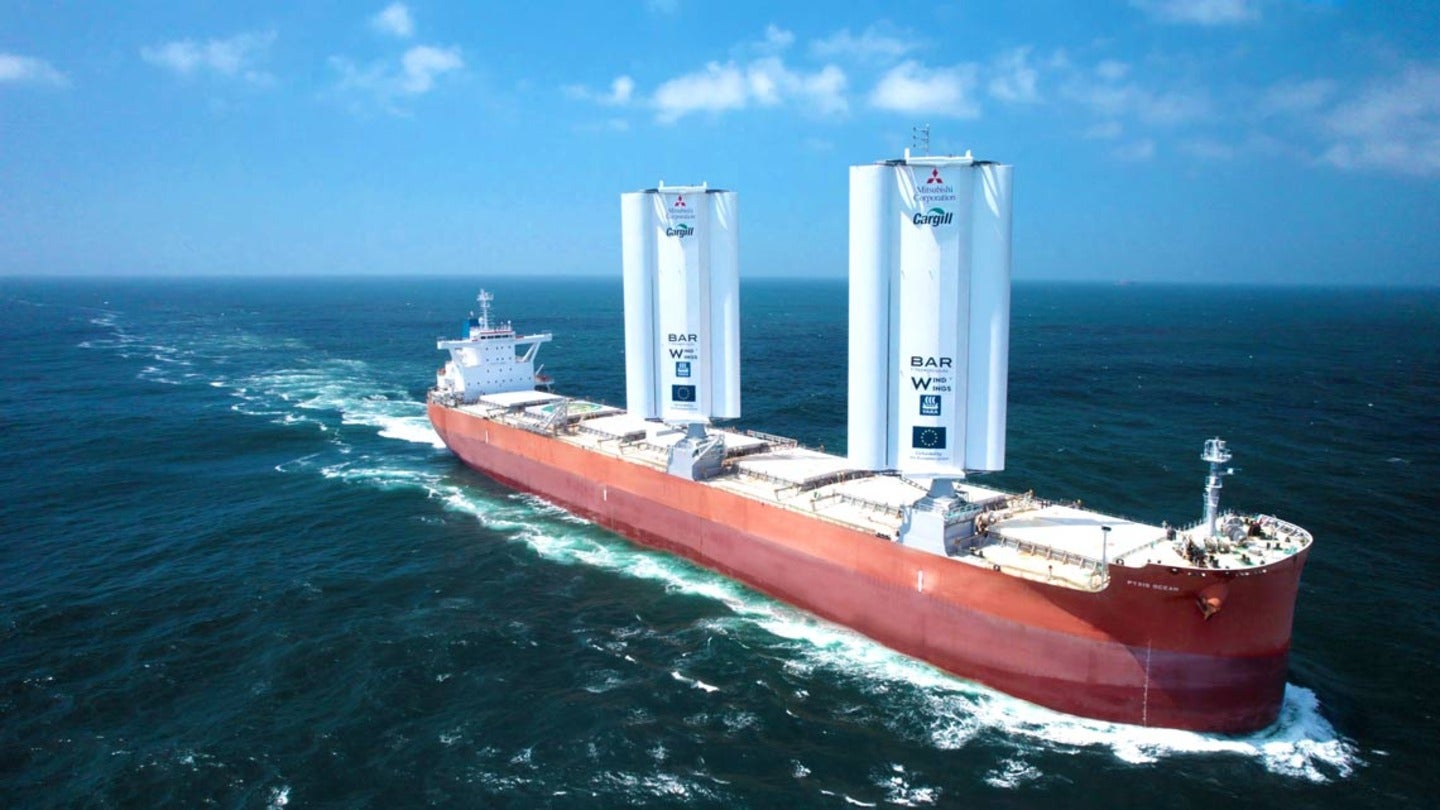World News26.03.2024
Winged cargo ship saves three tonnes of fuel per day on first voyage

QAZAQ GREEN. An age of greener, more efficient shipping may be in the offing as a specially modified 43,000-tonne bulk freighter completes a six-month sea trial using a combination of diesel engines and a set of high-tech automatic sails to catch the wind, New Atlas reports.
Mixing sail and power isn't a new thing. In fact, it goes back to the very first steamships when shipmasters weren't particularly keen to rely on a cranky, half-experimental portable steam engine to cross the ocean. Even today, all but the smallest sailing boats have some sort of auxiliary power for maneuvering in close quarters or making passages when the wind isn't blowing.
As engines improved, ships became the behemoths we know today, and shipping schedules became as tight as my budget, sails gradually disappeared from commercial ocean traffic, but the wind propulsion never disappeared entirely. Sails may never come back as the primary means of propelling a ship, but the promise of a way of supplementing power with wind as a way to cut fuel consumption and reduce toxic emissions has always been attractive, so long as it doesn't rely on acres of canvas and huge crews of sailors hauling on sheers.
Operated by MC Shipping Kamsarmax and chartered by Cargill, Singapore-flagged Pyxis Ocean was retrofitted with two WindWings developed by BAR Technologies and carried out an extended six-month sea trial beginning in August 2023. During this time, it sailed across the Indian Ocean, Pacific Ocean, North and South Atlantic, and passed Cape Horn and the Cape of Good Hope.
The WindWings aren't the sort of canvas sails that you see on old pictures of the Cutty Sark. Instead, they are solid, foldable sails made of steel and glass fibers and stand 37.5-m (123-ft) tall. Their purpose isn't to replace the conventional diesel engines, but to provide supplemental propulsion as the ship sails into areas with favorable winds and currents.
They also don't require much of any minding. A simple red/green traffic system on the bridge tells the crew when to activate or inactivate the WindWings. Once online, they respond automatically to changes in the wind and trim themselves for optimum speed. This allows the diesels to be throttled back without the ship slowing down.
According to Cargill, this allowed the Pyxis Ocean to save the equivalent of three tonnes of fuel per day with a reduction in carbon dioxide emissions of 11.2 tonnes (the equivalent of removing 480 cars from the road for the extent of the voyage) and a general savings of 14%.
The next step is to make sure that such large-scale sail-equipped ships are compatible with 250 global shipping ports
"The results of the Pyxis Ocean’s first voyage with WindWings installed clearly demonstrate that wind assisted propulsion can secure significant fuel savings and emissions reduction," said John Cooper, BAR Technologies CEO. "For example, in near optimum sailing conditions, during an open sea voyage, the Pyxis Ocean achieved fuel savings of 11 tonnes per day. And while the Pyxis Ocean has two WindWings, we anticipate the majority of Kamsarmax vessels will carry three wings, further increasing the fuel savings and emissions reductions by a factor of 1.5. With Cargill are now able to validate our performance predictions and modeling in real-world conditions, it’s an exciting time as we begin to roll out WindWings production globally."
Astana to host Electronica Expo Kazakhstan Electronics Exhibition
WB gives rundown of Azerbaijan's green energy grid volume prospects
US solar sets new records as renewables nearly match natural gas – EIA
‘Wings’ on poles: Bill Gates-backed breakthrough wind turbine facility breaks ground
Perovskite tandem solar cell achieves new efficiency record
Kazakhstan and China endorse draft SCO joint statement on sustainable energy development
Innovative research on organic solar cells for space applications
Kazakhstan and Uzbekistan drive green energy progress in Central Asia
KazMunayGas launches pilot green hydrogen project in Atyrau
How private homeowners in Kazakhstan can make money from solar panels
14 countries are investing in Kazakhstan's renewable energy sector through auctions
How green hydrogen could transform Kazakhstan’s energy sector
IKEA offers ready-to-use solar power systems for balconies
Adani commissions India’s first off-grid green hydrogen pilot plant
Tajikistan unveils green energy roadmap at international conference in Dushanbe
Hydropower projects selected through KOREM Auction in Kazakhstan
EU reaches political deal to simplify CBAM
New research could unlock the potential of bladeless wind turbines
Uzbekistan to launch 16 renewable energy facilities by the end of 2025
Kazakhstan holds auction for 50 MW of small hydropower projects











